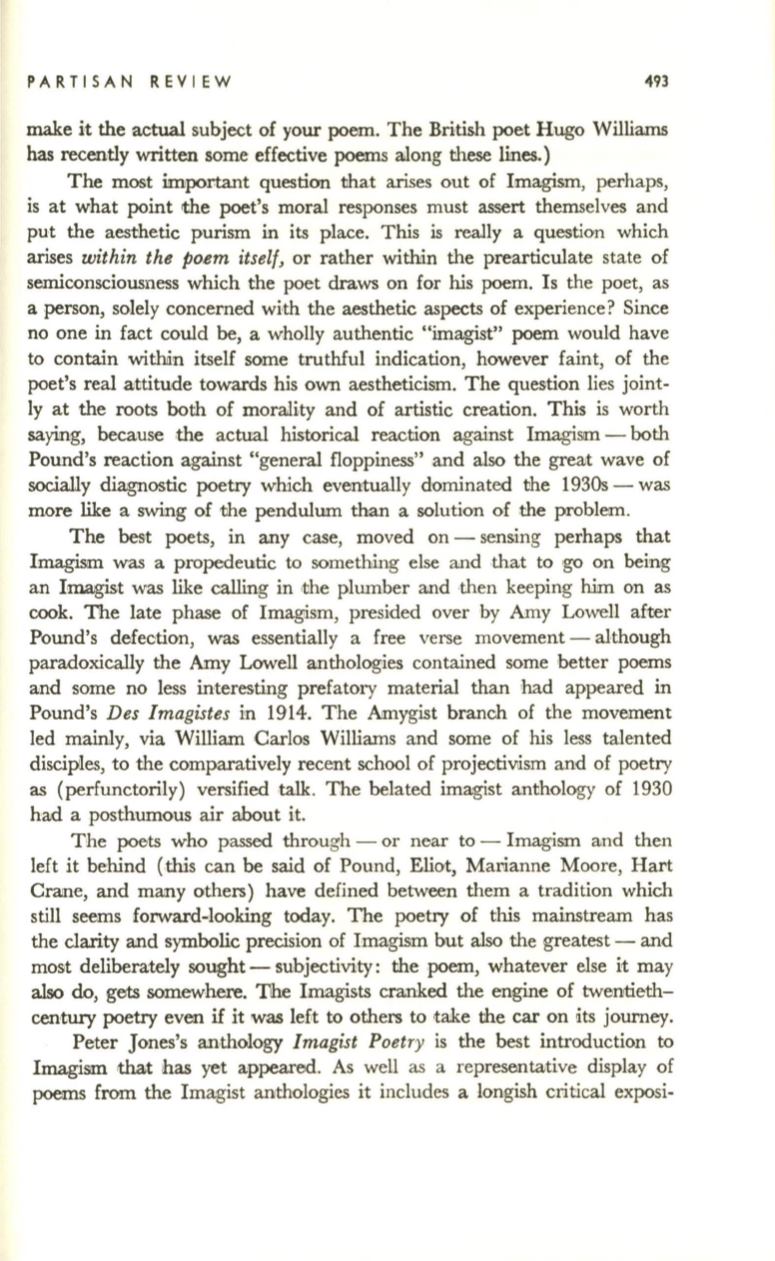
PARTISAN REVIEW
493
make it the actual subject of your poem. The British poet Hugo Williams
has
recently written some effective
poems
along these lines.)
The most important question that arises out of Imagism, perhaps,
is at what point the poet's moral responses must assert themselves and
put the aesthetic purism
in
its place. This is really a question which
arises
within the poem itself,
or rather within the prearticulate state of
semiconsciousness which the poet draws on for his poem. Is the poet, as
a person, solely concerned with the aesthetic aspects of experience? Since
no one in fact could be, a wholly authentic "imagist"
poem
would have
to contain within itself some truthful indication, however faint, of the
poet's real attitude towards his own aestheticism. The question lies joint–
ly at the roots both of morality and of artistic creation. This is worth
saying, because .the actual historical reaction against Imagism - both
Pound's reaction against "general floppiness" and also the
great
wave of
socially diagnostic poetry which eventually dominated the 19305 - was
more like a swing of the pendulum than a solution of the problem.
The best poets, in any case, moved on - sensing perhaps that
Imagism was a propedeutic
to
something else and that to go on being
an Imagist was like calling in ,the plumber and ,then keeping
him
on as
cook. The late phase of Imagism, presided over by Amy Lowell after
Pound's defection,
was
essentially a free verse movement - although
paradoxically the Amy Lowell anthologies contained some better poems
and some no less interesting prefatory material
than
had appeared in
Pound's
Des Imagistes
in 1914. The Amygist branch of the movement
led mainly, via William Carlos Williams and some of his less talented
disciples, to the comparatively recent school of
projectiv~sm
and of poetry
as (perfunctorily) versified
talk.
The belated imagist anthology of 1930
had a posthumous air about
it.
The poets who passed through - or near to - Imagism and then
left
it
behind (this can be said of Pound, Eliot, Marianne Moore, Hart
Cra!Ile, and many others) have defined between them a tradition which
still seems forward-looking today. The poetry of this mainstream has
the clarity and symbolic precision of Imagism but also the greatest - and
most deliberately sought - subjectivity: the
'poem,
whatever else it may
also
do,
gets somewhere. The Imagists cranked the engine of tweilitieth–
century poetry even
if
it was left to others to take the car on !its journey.
Peter Jones's anthology
Imagist Poetry
is the best introduction
to
Imagism that has yet appeared. As well as a representaJtive display of
poems from the Imagist anthologies it includes a longish critical exposi-


